
The New General Catalogue of Nebulae and Clusters of Stars is an astronomical catalogue of deep-sky objects compiled by John Louis Emil Dreyer in 1888. The NGC contains 7,840 objects, including galaxies, star clusters and emission nebulae. Dreyer published two supplements to the NGC in 1895 and 1908, known as the Index Catalogues, describing a further 5,386 astronomical objects. Thousands of these objects are best known by their NGC or IC numbers, which remain in widespread use.

A dwarf galaxy is a small galaxy composed of about 1000 up to several billion stars, as compared to the Milky Way's 200–400 billion stars. The Large Magellanic Cloud, which closely orbits the Milky Way and contains over 30 billion stars, is sometimes classified as a dwarf galaxy; others consider it a full-fledged galaxy. Dwarf galaxies' formation and activity are thought to be heavily influenced by interactions with larger galaxies. Astronomers identify numerous types of dwarf galaxies, based on their shape and composition.
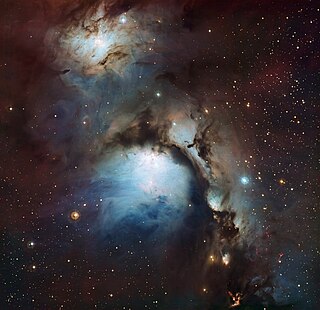
Messier 78 or M78, also known as NGC 2068, is a reflection nebula in the constellation Orion. It was discovered by Pierre Méchain in 1780 and included by Charles Messier in his catalog of comet-like objects that same year.
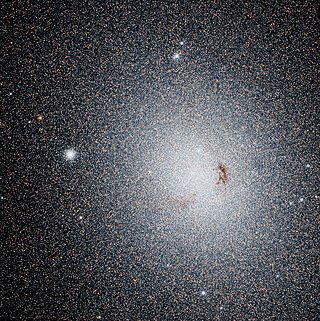
NGC 185 is a dwarf spheroidal galaxy located 2.08 million light-years from Earth, appearing in the constellation Cassiopeia. It is a member of the Local Group, and is a satellite of the Andromeda Galaxy (M31). NGC 185 was discovered by William Herschel on November 30, 1787, and he cataloged it "H II.707". John Herschel observed the object again in 1833 when he cataloged it as "h 35", and then in 1864 when he cataloged it as "GC 90" within his General Catalogue of Nebulae and Clusters. NGC 185 was first photographed between 1898 and 1900 by James Edward Keeler with the Crossley Reflector of Lick Observatory. Unlike most dwarf elliptical galaxies, NGC 185 contains young stellar clusters, and star formation proceeded at a low rate until the recent past. NGC 185 has an active galactic nucleus (AGN) and is usually classified as a type 2 Seyfert galaxy, though its status as a Seyfert is questioned. It is possibly the closest Seyfert galaxy to Earth, and is the only known Seyfert in the Local Group.
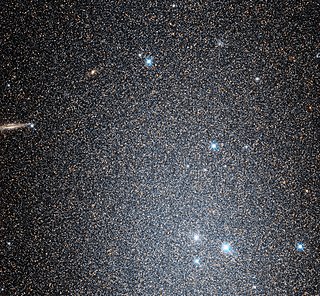
NGC 147 is a dwarf spheroidal galaxy about 2.58 Mly away in the constellation Cassiopeia. NGC 147 is a member of the Local group of galaxies and a satellite galaxy of the Andromeda Galaxy (M31). It forms a physical pair with the nearby galaxy NGC 185, another remote satellite of M31. It was discovered by John Herschel in September 1829. Visually it is both fainter and slightly larger than NGC 185. This means that NGC 147 is more difficult to see than NGC 185, which is visible in small telescopes. In the Webb Society Deep-Sky Observer's Handbook, the visual appearance of NGC 147 is described as follows:
Large, quite faint, irregularly round; it brightens in the middle to a stellar nucleus.

NGC 246 is a planetary nebula in the constellation Cetus. It is the first known planetary nebula to have a hierarchical triple star system at its center. The nebula and the stars associated with it are listed in several catalogs, as summarized by the SIMBAD database. NGC 246 was discovered by William Herschel in 1785.

A dwarf spiral galaxy is the dwarf version of a spiral galaxy. Dwarf galaxies are characterized as having low luminosities, small diameters, low surface brightnesses, and low hydrogen masses. The galaxies may be considered a subclass of low-surface-brightness galaxies.
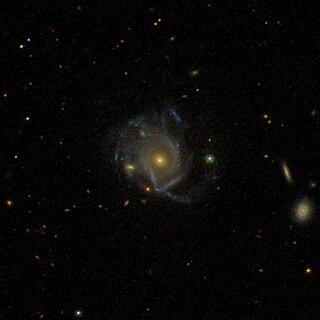
NGC 60 is an Sc type spiral galaxy in the Pisces constellation. NGC 60 is noticed for its unusually distorted spiral arms, which are commonly due to gravitational effects of neighboring galaxies, but there are no galaxies around NGC 60 to allow this.
Veliki Krčimir is a village situated in Gadžin Han municipality in Serbia.

"Legacy Survey Sky Browser". www.legacysurvey.org. Retrieved 2023-05-19.
The 1967 NPSL Final was the National Professional Soccer League's postseason championship final of the 1967 season. The event was contested in a two-game aggregate match between the Oakland Clippers and the Baltimore Bays. The first leg was played on September 3, 1967 at Memorial Stadium in Baltimore, Maryland, with the Bays winning 1–0. The return leg was contested on September 9, 1967 at the Oakland-Alameda Coliseum in Oakland, California, and the Clippers won it by the score of 4–1. With the two-day competition complete, the Oakland Clippers held a 4–2 aggregate lead and were crowned the 1967 NPSL champions.

NGC 68 is a lenticular galaxy, and the central member of the NGC 68 group, in the constellation Andromeda. The galaxy was discovered on September 11, 1784, by William Herschel, who observed the NGC 68 group as a single object and described it as "extremely faint, large, 3 or 4 stars plus nebulosity". As such, his reported location is between NGC 68, NGC 70, and NGC 71. By the time Dreyer looked at the galaxies to add to the NGC catalog, however, he was able to tell that the single galaxy observed by Herschel was in fact 3 adjacent galaxies, and cataloged them as NGC 68, NGC 70, and NGC 71.

NGC 70 is a spiral galaxy located in the constellation Andromeda. It was discovered on October 7, 1855, by R. J. Mitchell and was also observed on December 19, 1897 by Guillaume Bigourdan from France who described it as "extremely faint, very small, round, between 2 faint stars".
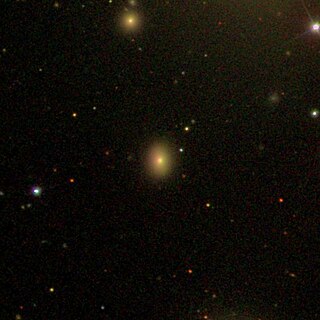
NGC 386 is an elliptical galaxy located in the constellation Pisces. It was discovered on November 4, 1850, by Bindon Stoney. It was described by Dreyer as "considerably faint, small, round." Along with galaxies NGC 375, NGC 379, NGC 382, NGC 383, NGC 384, NGC 385, NGC 387 and NGC 388, NGC 386 forms a galaxy cluster called Arp 331.

NGC 523, also known as Arp 158, from the ARP catalog is a spiral galaxy located in the constellation Andromeda. It was discovered separately by William Herschel on 13 September 1784, and by Heinrich d'Arrest on 13 August 1862. d'Arrest's discovery was listed as NGC 523, while Herschel's was listed as NGC 537; the two are one and the same. John Dreyer noted in the New General Catalogue that NGC 523 is a double nebula.
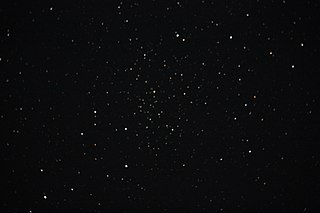
NGC 6940 is an open cluster in the constellation Vulpecula. It was discovered by William Herschel in 1784. The cluster is nearly a billion years old and it is located 2,500 light years away. It is considered the finest open cluster in the constellation.

NGC 2071 is a reflection nebula in the constellation Orion. It was discovered on January 1, 1784, by William Herschel. It is part of a group of nebulae that also includes Messier 78, NGC 2064, and NGC 2067.
NGC 2064 is a reflection nebula in the constellation Orion. It was discovered on January 11, 1864 by Heinrich d'Arrest. It is part of a group of nebulae, that also includes Messier 78, NGC 2071 and NGC 2067.
Interoperable Master Format (IMF) is a container format for the standardized digital delivery and storage of finished audio-visual masters, including movies, episodic content and advertisements.













